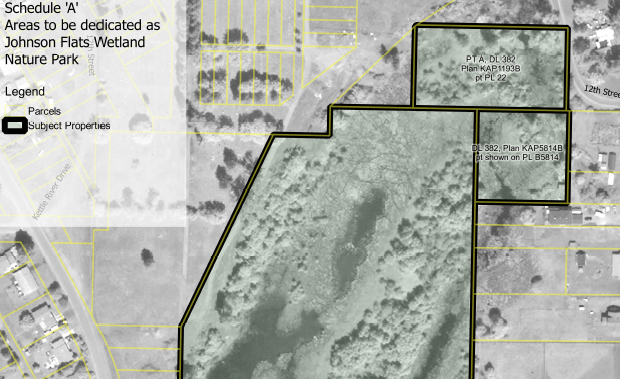City looks to designate new nature park for Johnson Flats
The City of Grand Forks is ready to put the stamp on its latest green space addition.
Grand Forks city council has passed first, second and third reading of the proposed Johnson Flats Wetland Nature Park bylaw at its Oct. 11 and 24 meetings.
The area was first came on the radar when city council moved to designate the area as a protected natural area through the Sustainable Community Plan (SCP) and zoning bylaw amendments.
As a result, the city began a five-year update of the SCP which would contain the planning needed, and options for natural protection and dedication for high priority areas in advance of zoning and SCP amendments.
It was found that dedication of the wetland through a bylaw as a park — with the intended use as an ecological reserve — would provide immediate protection of the land.
A park dedication bylaw provides greater protection than a rezoning bylaw because council can only remove the dedication by bylaw with the approval of the electors.
The city held an open house on Oct. 18, along with third reading of the bylaw on Oct. 24. The final reading and adoption of the bylaw is set to take place in council chambers on Nov. 7.
The process for the Johnson Flats began on May 9. It was eventually found that three additional and city-owned parcels were within the wetland area and city staff recommended that the lands be included in the protected area.
The parcels were designated agricultural/rural in the SCP and are located in the 200-year floodplain. Ecological reserves can occur in any land use zone.
The park must still pass third and fourth reading before adoption. The adoption of a park dedication must be by an affirmative vote of at least two thirds of all members of council.
Permitted uses for the land
Parks and ecological reserves are permitted uses on agricultural land reserve (ALR) lands, as biodiversity conservation, passive recreation, heritage, wildlife and scenery viewing purposes, as long as the area occupied by any associated buildings and structures do not exceed 100 square metres for each parcel.
Definition of nature park
Nature Parks are park spaces that are relatively undisturbed and contain a high percentage of native species, providing habitats for a diversity of vegetation and wildlife.
They are natural or near natural in character, or are in the process of recovery from human disturbance.
These natural areas may represent or contain fragments of regionally important ecosystems, and they may contain habitat for endangered plant and animal species.
Nature parks generally require less routine and intensive management to ensure their sustainability.
Source: City of Grand Forks
Park regulations
As a designated ecological reserve, no person “shall modify or cause to modify the hydrology, vegetation, or wildlife of the park in a way that diminishes the function of the park as a wetland or an ecological reserve.”
Power pole program
The city has begun to replace and assess its over 500 power poles.
The City of Grand Forks public works department, along with the assistance of Gilnockie Inspection, will be conducting a condition assessment of approximately 540 of the city’s power poles.
The process will require both an above and below ground inspection.
“As a general rule, most power poles are on public property, however, in the event that they may need to access city-owned poles on private property, an attempt will be made to inform the owner by knocking on their door when the inspectors are onsite,” read a city media release.
This inspection is to ensure continued reliability of the power system which in turn supports public safety, the report stated.






















